| The Ford Hunger March began on Detroit's east side and proceeded 10 miles seeking relief during the Great Depression. Facing hunger and evictions, workers had formed neighborhood Unemployed Councils. Along the route, the marchers were given good wishes from Detroit Mayor Frank Murphy as well as two motorcycle escorts, and thousands joined the marchers along the route. |  |
At the Detroit city limit, the marchers were met by Dearborn police and doused by fire hoses.
Despite the cold weather, they continued to the Employment Office of the Ford River Rouge plant,
from which there had been massive layoffs.
Five workers were killed and nineteen wounded by police and company "security" armed with pistols, rifles and a machine gun. |  | | 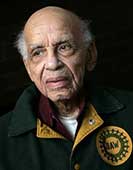
| According to Dave Moore, one of the marchers, "That blood was black blood and white blood. One of the photos that was published in the Detroit Times, but never seen since, shows a black woman, Mattie Woodson, wiping the blood off the head
of Joe DiBlasio, a white man who lay there dying . . .
It's been 75 years, but when you drive down Miller Road today, your car tires will be moistened with the blood that those five shed." Grave markers with the words "His Life for the Union" pay tribute to the fallen hunger marchers in Woodmere Cemetery on Detroit's west side. | | Dave Moore | | | |
| 525 civil rights advocates began a 54-mile march on a Sunday morning from Selma, Alabama, to the capital of Montgomery, to promote voting rights for blacks. Just after crossing the Edmund Pettus Bridge on the outskirts of Selma, the marchers were attacked in what became known as Bloody Sunday. | | 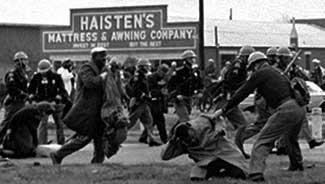
| Enforcing an order by Gov. George Wallace, the group was broken up by state troopers and volunteer officers of the Dallas County sheriff who used tear gas, nightsticks, bullwhips and rubber tubing wrapped in barbed wire. John Lewis, then head of the Student Nonviolent Coordinating Committee and a leader of the march (and now a member of Congress from Georgia), suffered a fractured skull. | | ABC television interrupted a Nazi war crimes documentary, "Judgment at Nuremberg," to show footage of the violence in Selma, confusing some viewers about who was beating whom. | 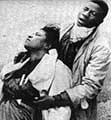 | | Injured in Selma | Selma 1965 - Edmund Pettus Bridge, video excerpt from a PBS documentary with Rep. John Lewis and others who were there
| | | |
| A Federal Court ruled in Atlanta, Georgia, that a peace group must have the same access to students at high school career days as military recruiters. the anti-recruitment movement today: LEAVE MY CHILD ALONE!
|  | | |
Thousands of workers in the New York needle trades (primarily women) demonstrated and began a strike for higher wages, a shorter workday and
an end to child labor. |  |  | This event became the basis for International Women's Day celebrated all over the world
since March 8, 1945. | | | 2010 theme for International Women's Day:
Equal rights, equal opportunities: Progress for all
| | | |
| About 3,500 U. S. Marines became the first American combat troops in Vietnam, landing near the coastal city of Da Nang. The ships USS Henrico, Union, and Vancouver, carrying the 9th Marine Expeditionary Brigade under Brig. Gen. Frederick J. Karch, took up stations 4,000 yards off Red Beach Two, north of Da Nang. | 
| | |
| 40,000 in Tel Aviv, Israel, organized by Peace Now, rallied against the war in Lebanon. | |
Women in Black demonstrated in the center of Belgrade, Serbia, on International Women's Day, expressing solidarity with Kosovar women: "The Albanian women from Kosovo are our sisters." The women were both spit at and kicked, but didn't give up, and stood there to the end of the usual hour.
Though Kosovo is overwhelmingly (90%) ethnically Albanian, it is considered the national and religious birthplace of Serbians. Both Kosovo and Serbia had been part of the former Yugoslavia, which had granted partial autonomy to Kosovo in 1974. Serbian President Slobodan Milosevic (later tried for war crimes) in 1989 withdrew that autonomy and revoked the official status of the Albanian language in Kosovo. |  | | |
| The U.S. Supreme Court, with only one dissent, freed the slaves who had seized the Spanish slave ship Amistad, ruling that they had been illegally forced into slavery, and thus were free under American law. | | 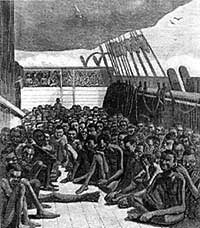 Slave ship Slave ship
| They had mutinied and taken control of the ship off the shore of Cuba (then a colony of Spain) and demanded to be taken back to Africa but wound up in U.S. waters off the coast of Long Island, New York. |  | | | |
| Five Sioux Indians, led by Richard McKenzie, claimed the island of Alcatraz in San Francisco Bay as Indian land. The island had recently been abandoned, and the action was based on an 1868 treaty which entitled Inidans to take possession of surplus federal land. The native Americans advocated turning it into a cultural center and Indian university, but their occupation lasted only four hours. | | |
Two days after Bloody Sunday [see March 7, 1965] Rev. Martin Luther King, Jr. led 1500 outraged people gathered from around the country back to the Edmund Pettus Bridge on the outskirts of Selma, Alabama. They were attempting for a second time to march to the state capital of Montgomery in support of voting rights for black Americans. Confronted once again by state troopers blocking passage to the bridge, King knealt in prayer, then led his followers back, avoiding further violence.
Later that evening three white ministers were attacked by locals as they left a soul food restaurant in Selma. Rev. James Reeb was struck on the head with a club and died two days later. | | "Deputy Lineup." Alabama Sheriff's deputies block
the progress of marchers in Selma, Alabama. | |
|
|
James Earl Ray was sentenced to prison for 99 years by a court in Memphis, Tennessee, after admitting he murdered American civil rights leader Dr. Martin Luther King, Jr. King, who preached and practiced nonviolence, was shot dead by a sniper in Memphis as he stood on the balcony of the Lorraine Motel.
The building now houses the National Civil Rights Museum.
| 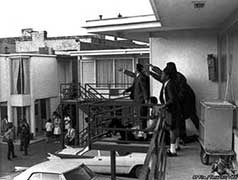
| | Witnesses pointing toward the source of the shot that killed King. | | |
| Turkish conscientious objector (CO) Mehmet Tarhan was released unexpectedly from a military prison after being held for having refused service in the army. A court decided that he had already been held longer (23 months) than any possible sentence for the crime. | |  | | Mehmet Tarhan | |  Mehmet Tarhan's supporters Mehmet Tarhan's supporters
| He was ordered, however, to present himself again for military service and thus be subject to re-arrest for the same offense.
War Resisters' International(WRI) led an international support campaign for him along with other CO activists in Turkey. | | | |
| Cesar Chavez ended a 23-day fast for U.S. farm workers in a Delano, California, public park with 4000 supporters at his side, including Sen. Robert Kennedy (D-New York). Cesar Chavez led the effort to organize farm workers into a union for better pay, working and living conditions. | 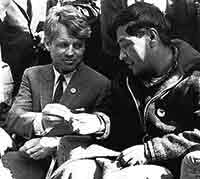
| | |
| 
| 10 days of protest and direct action ensued demanding an end to nuclear testing at the Nevada Test Site. The site, larger than the state of Rhode Island, is an outdoor laboratory and national experimental center for testing nuclear weapons. The actions resulted in over 2,200 arrests, the largest number of arrests in U.S. history for a political protest outside Washington, D.C. | | |
| Maximilian of Thebeste (near Carthage in North Africa) was beheaded by Romans after refusing military service because he said his Christian beliefs did not permit him to become a soldier. | |
|
| Workers led by the Industrial Workers of the World (IWW) won the Lawrence, Massachusetts, "Bread & Roses" textile strike after 32,000 workers (mostly young female immigrants who spoke 25 different languages, half between the ages of 14 and 18) stayed out for nine weeks. They were striking for a wage increase, double time for overtime and safer working conditions: the equipment was dangerous and the air quality caused lung disease in about one-third of the workers before the age of twenty-five. | | 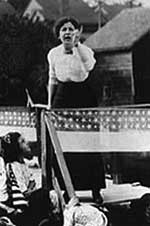
| "Bread and Roses" became the strikers slogan and inspired a poem by by the same name. <IWW organizer Elizabeth Gurley Flynn addresses a strike rally | 
Bread & Roses victory parade | |
| Gandhi's Salt March began from Ahmadabad with 76 followers to protest the salt tax. Great Britain's Salt Acts prohibited Indians from collecting or selling salt, a staple in the Indian diet. | 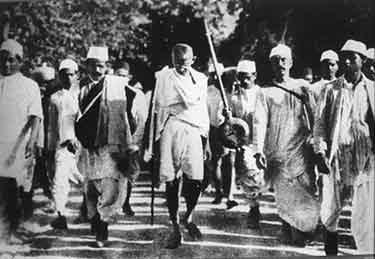 | Citizens were forced to buy it from the British, who, in addition to exercising a monopoly over the manufacture and sale of salt, also exerted a heavy salt tax. Defying the Salt Acts, Gandhi reasoned, would be a simple way for many Indians to break a British law nonviolently, increasing the pressure for independence.
By the time Gandhi had covered the 241 miles to the coastal city of Dandi on the Arabian Sea, the number of marchers had grown into the thousands. | | Gandhi leading the Salt March | |
|
| 150,000 demonstrated against construction of a nuclear power plant in Lemoniz, Spain, part of the Basque region. No fewer than a dozen plants were planned in a relatively small, densely populated area, Lemoniz being only 12 km (5 miles) from Bilbao, a city of a million.
The opposition was concerned about the possibility of accidents. | 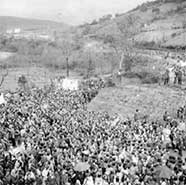 | | Lemoniz protest | |
The term "rat," referring to a worker who betrays the interests of fellow workers, first appeared in print. The New York Daily Sentinel reported on replacement workers who had agreed to work for two-thirds of the going rate.
" . . . [many printers are out of work, others are being paid about 2/3 the regular pay; they should join in cooperative associations, 'as we have done']
" [While] the master printers [fill] their offices with boys and two-thirds men, alias 'rats,' it will be difficult to find a remedy." | | |
| The first contingent of 14,030 Navajo reached Fort Sumner, New Mexico. Men, women and children had been forced to march almost 400 miles from northeastern Arizona and northwestern New Mexico to Bosque Redondo, a desolate tract on the Pecos River in eastern New Mexico. Traveling in harsh winter conditions for almost two months, about 200 Navajo died of cold and starvation along the way. More died after they arrived at the barren reservation. The forced march, led by Kit Carson, an Indian agent and military leader in both the Mexican and Civil Wars, became known by the Navajos as the "Long Walk." | | 
A grueling 400-mile march to imprisonment in a sterile land. | | |
| Pax Christi, an international Catholic peace organization was founded in France. From their website: "Pax Christi is a ground up organization – it began with a few committed people who spoke out, prayed and worked for reconciliation at the end of the second world war, and is now active in more than 60 countries and five continents, with more than 60,000 members worldwide." | | |
| Clouds of nerve gas drifted outside the Army's Dugway Proving Grounds in Utah, poisoning 6,400 sheep in nearby Skull Valley. | 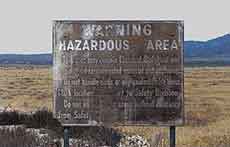
|
| | Sign near Dugway: Warning Hazardous Area: This area may contain Chemical, Biological and Radiological contaminated material and explosives . . . | |










 Slave ship
Slave ship
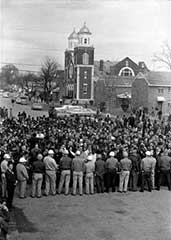


 Mehmet Tarhan's supporters
Mehmet Tarhan's supporters







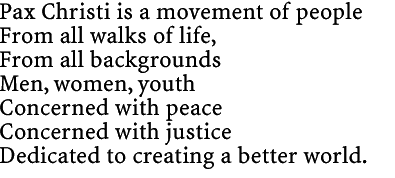

No comments:
Post a Comment